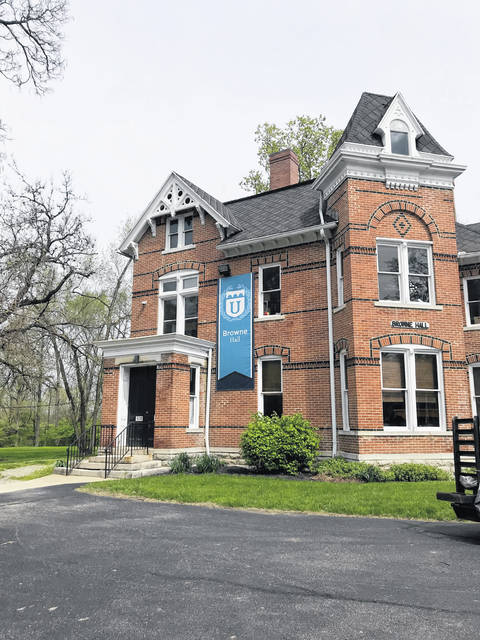
Editor’s note: This article is one of a series of articles provided by the Champaign County Preservation Alliance and leading up to the annual Historic Home & Garden Tour. This year’s tour is an opportunity to visit eight homes, a couple museums, a garden, a church, a business and a railroad car. The tour is 11 a.m.-5 p.m. June 29 and 30 in Urbana. Pre-sale tickets are available at local banks and retailers, and a complete list is available at www.ccpapreserveohio.org
Browne Hall is a delight to the eye. This three-story 1880 structure on the Urbana University campus, 27 College Way, is the home of the Johnny Appleseed Education Center and Museum. The museum holds the largest collection of memorabilia and written information about the life of John “Appleseed” Chapman in the world. Johnny Appleseed became famous for his many nurseries of apple trees. Just as he was a proponent of the apple tree, so was he a proponent of the Swedenborgian Church and in that capacity was often in Urbana meeting with fellow congregants.
The building is in the Victorian sub-style “Queen Anne” style. This architectural style features “over the top” decoration including towers, dormers, scroll work, brackets, paired windows and decorative shingles and brickwork. Browne Hall features all of these features. Tour-goers should note the distinctive brickwork featuring clinkers (burned bricks) placed in five belt-courses and over the doors and windows. Two of the belt-courses have a row of dogtooth bricks (bricks placed with an edge projecting) between them.
This building has been a private residence, a school, a women’s dormitory and now a museum. It is named after Myron Browne, a Swedenborgian minister and member of the Board of Trustees of Urbana University. Long ago it was rumored that a ghost inhabited the third floor, but there have been no sightings in the recent past.
Browne Hall was built in 1880 by Thomas Moses, professor of natural science at Urbana University and president for nearly 10 years. The rear part of the building is of much older construction. The building was sold a number of times and eventually was purchased at a sheriff’s auction by John H. James (a trustee of Urbana University) for $4,300. In 1918 James sold the building to Urbana University for $100 plus back taxes.
The house was modified for use as a female dormitory and was christened “Browne Hall.” The original female dormitory was a large brick house then on the northeast corner of S. High and W. Water streets (now 226 W. Water Street). That house still stands, but its front yard was subdivided by the university in 1918 and now sports five residences on W. Water Street. Myron Browne had raised the money to purchase this house and it was the first “Browne Hall” for Urbana University.
The Johnny Appleseed Museum was established in 1996 at Urbana University. In addition to its research library, it also displays a cider press used by John James to process apples from trees planted by Johnny Appleseed in Champaign County. It also displays wood and bark from original trees planted by Johnny Appleseed in Ohio and Indiana and photos of monuments and markers dedicated to Johnny Appleseed.
The apple trees surrounding Browne Hall are grown from seedlings of the last known surviving apple trees planted by John “Johnny Appleseed” Chapman.


